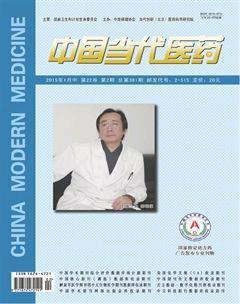血液透析患者血栓形成的相关因素分析
胡浩强++周红梅++刘国辉
[摘要] 目的 探讨血液透析患者血栓形成的相关因素。 方法 纳入本院2012年1~12月血液透析3个月以上的患者151例,根据研究18个月内是否有血栓形成分为血栓组和无血栓组,记录相关临床资料,通过Logistic回归分析血栓形成的相关因素。 结果 单因素Logistic回归分析显示,高同型半胱氨酸血症与血管内血栓形成无相关性(P=0.132),年龄、糖尿病、口服阿司匹林是血管内血栓形成的相关因素(P<0.05)。多因素Logistic回归分析显示,口服阿司匹林是血管内血栓形成的独立相关因素(P<0.05)。 结论 口服阿司匹林是血液透析患者血栓形成的相关因素,高同型半胱氨酸血症与血管内血栓形成无相关性。
[关键词] 高同型半胱氨酸血症;血管通路;血栓形成;血液透析;Logistic回归分析
[中图分类号] R459.5 [文献标识码] A [文章编号] 1674-4721(2015)01(b)-0045-03
Related factors analysis of thrombosis in patients with hemodialysis
HU Hao-qiang ZHOU Hong-mei LIU Guo-hui
Department of Nephrology,People′s Hospital of Dongguan City in Guangdong Province,Dongguan 523000,China
[Abstract] Objective To study the associate factors of thrombosis in patients with hemodialysis. Methods 151 patients with hemodialysis more than three months in our hospital from January to December 2012 were recruited in this study.All patients were divided into thrombosis group and non-thrombosis group according to whether the patient had thrombosis during the 18 months,the clinical data were recorded and correlation of high homocysteine and other factors associated with thrombosis were analyzed through Logistic regression analysis. Results Single factor Logistic regression analysis showed,high homocysteine level with intravascular thrombosis had no relevance(P=0.132),age,diabetes,oral aspirin were related factors of intravascular thrombosis(P<0.05).Multiariable Logistic regression analysis showed that oral aspirin was the independence of related factor of intravascular thrombosis(P<0.05). Conclusion Oral aspirin is relative factors of thrombosis in patients receiving hemodialysis.High homocysteine level with intravascular thrombosis has no relevance.
[Key words] Hyperhomocysteinemia;Vascular access;Thrombosis;Hemodialysis;Logistic regression analysis
在血液透析患者中,血管通路失败是导致其并发症发生及死亡的一个重要因素[1]。关于血管通路血栓形成的危险因素,目前了解尚少。研究认为,中心静脉置管较动静脉内瘘更易形成血管通路血栓[2]。另有研究表明,糖尿病、老年、女性、低白蛋白血症、升高的低密度脂蛋白、置管的血管狭窄等是血栓形成的重要危险因素[3-5]。在肾功能正常的患者中,高同型半胱氨酸血症是动脉和静脉血栓形成的独立危险因素。在血液透析患者中,有研究称,高同型半胱氨酸血症是血管通路血栓形成的一个危险因素。升高的血浆同型半胱氨酸可通过影响早期动脉粥样斑块的形成,影响内皮细胞、抑制抗凝剂、提高促凝剂的效果[6]。但也有研究显示,高同型半胱氨酸血症与血液透析患者血管通路血栓形成无明显相关性[7-9]。本研究通过回顾性研究本院血液透析患者,探讨高同型半胱氨酸血症、性别、年龄、高血压、糖尿病等因素是否与血管通路血栓形成有一定相关性。
1 对象与方法
1.1 研究对象
选取2012年1~12月在本院规律行血液透析患者151例为研究对象,其中男91例(60.3%),女60例(39.7%),平均血液透析时间(26.45±23.23)个月。纳入标准:在本院规律血液透析>3个月,年龄≥18岁,完成基础临床评估及实验室检查。排除标准:有抗磷脂抗体综合征病史或1个月内有抗凝治疗的患者。所有患者签署知情同意书。根据血液透析18个月是否有血栓形成分为血栓组63例及无血栓组88例。
1.2 方法
收集患者18个月内血栓形成的数量、性别、年龄、既往病史、血液透析病程、平均低密度脂蛋白(LDL)、平均铁蛋白水平及阿司匹林摄入量。血浆同型半胱氨酸的水平于签署知情同意书后立即测定。测定方法采用高效液相色谱法(Agilent 1100系列液相色谱仪,美国Agilent公司)。
1.3 统计学处理
采用SPSS 16.0统计软件对数据进行分析和处理,计量资料以x±s表示,采用t检验,计数资料采用χ2检验,相关因素采用Logistic回归分析,以P<0.05为差异有统计学意义。
2 结果
2.1 两组患者临床资料的比较
血栓组女性患者比例稍高(P=0.013),两组年龄、同型半胱氨酸、LDL、铁蛋白水平,高血压、糖尿病及冠心病发生率比较差异无统计学意义(P>0.05)(表1)。
2.2 血栓形成相关因素的Logistic回归分析
单因素Logistic回归分析显示,年龄、糖尿病、口服阿司匹林是血栓形成的相关因素;多因素Logistic回归分析显示,口服阿司匹林是血栓形成的独立相关因素,同型半胱氨酸水平与血栓形成无相关性(P=0.132)(表2)。
3 讨论
动静脉内瘘的建立是尿毒症患者进行血液透析的基本条件之一,然而在使用过程中会出现各种并发症,内瘘血栓形成最为常见,是内瘘失功的重要原因之一,因此了解血栓形成的高危因素较为重要。
本研究通过回顾性分析本院151例血液透析患者,结果显示年龄、糖尿病、口服阿司匹林是血管内血栓形成的相关因素,在校正年龄、性别、糖尿病后,多因素Logistic回归分析显示,口服阿司匹林是其独立相关因素,同型半胱氨酸水平与血栓形成无相关性。高半胱氨酸由体内的重要氨基酸蛋氨酸转化过来。在肾功能正常的群体中,升高的同型半胱氨酸是动静脉血栓形成的独立危险因素,在进行血液透析的终末期肾病患者中亦常见同型半胱氨酸升高,其原因目前尚不明确,除可观察到清除减少外[10],遗传或透析相关因素或许亦有参与[5]。高同型半胱氨酸血症是促进动脉粥样硬化和冠心病的一个重要的危险因素,还与终末期肾病患者反复形成静脉血栓有关[11]。另外,其还可加速氧化及衰老、降低免疫力、增加疼痛。血液透析患者中,高同型半胱氨酸血症与不良心血管事件存在显著相关性,血液透析患者血栓形成与高同型半胱氨酸血症密切相关。Bowden等[7-8]分别通过一项114例患者的回顾性研究及一项185例患者的前瞻性研究显示,长期的高同型半胱氨酸水平与血管内血栓形成并无明显相关性。另有台湾地区一项196例患者的研究得到相同的结果[9]。
高龄、糖尿病与早期血管疾病有关,但校正混杂因素后,研究并未观察到这种关联性,与Bowden等[7-8]的研究结果一致。抗血小板药物从20世纪问世一直应用至今,服用抗血小板药物能抗血小板黏附性和聚集性,是治疗心血管疾病、预防血栓事件的主要手段。研究显示,口服阿司匹林可显著降低血栓形成的风险,这更加证实了之前多项研究的观点[12-13]。
综上所述,血液透析患者中,口服阿司匹林是血管内血栓形成的相关因素,高同型半胱氨酸血症与血管内血栓形成无相关性。
[参考文献]
[1] Bessias N,Paraskevas KI,Tziviskou E,et al.Vascular access in elderly patients with end-stage renal disease[J].Int Urol Nephrol,2008,40(4):1133-1142.
[2] Choudhury D.Vascular access thrombosis prophylaxis[J].Semin Dial,2006,19(4):335-342.
[3] Di Iorio BR,Mondillo F,Bortone S,et al.Fourteen years of hemodialysis with a central venous catheter:mechanical long-term complications[J].J Vasc Access,2006,7(2):60-65.
[4] Heard KA,Russell TA.Access thrombosis,hospitalization,and hematocrit level in hemodialysis patients[J].Nephrol Nurs J,2000,27(6):607-611.
[5] Kim RJ,Becker RC.Association between factor V Leiden,prothrombin G20210A,and methylenetetrahydrofolate reductase C677T mutations and events of the arterial circulatory system:a meta-analysis of published studies[J].Am Heart J,2003,146(6):948-957.
[6] Williams KT,Schalinske KL.Homocysteine metabolism and its relation to health and disease[J].Biofactors,2010,36(1):19-24.
[7] Bowden RG,Wyatt FB,Wilson R.Homocysteine and vascular access thrombosis in end-stage renal disease patients:a retrospective study[J].J Nephrol,2002,15(6):666-670.
[8] Bowden RG,Wyatt FB,Wilson R,et al.Homocysteine and vascular access thrombosis in a cohort of end-stage renal disease patients[J].Ren Fail,2004,26(6):709-714.
[9] Chen TC,Wang IK,Lee CH,et al.Hyperhomocysteinemia and vascular access thrombosis among chronic hemodialysis patients in Taiwan:a retrospective study[J].Int J Clin Pract,2006,60(12):1596-1599.
[10] van Guldener C.Why is homocysteine elevated in renal failure and what can be expected from homocysteine-lowering?[J].Nephrol Dial Transplant,2006,21(5):1161-1166.
[11] Bhargava S,Parakh R,Manocha A,et al.Prevalence of hyperhomocysteinemia in vascular disease:comparative study of thrombotic venous disease vis-à-vis occlusive arterial disease[J].Vascular,2007,15(3):149-153.
[12] Desai AA,Nissenson A,Chertow GM,et al.The relationship between laboratory-based outcome measures and mortality in end-stage renal disease:a systematic review[J].Hemodial Int,2009,13(3):347-359.
[13] Fleischmann EH,Bower JD,Salahudeen AK.Are conventional cardiovascular risk factors predictive of two-year mortality in hemodialysis patients?[J].Clin Nephrol,2001,56(3):221-230.
(收稿日期:2014-10-31 本文编辑:李亚聪)

